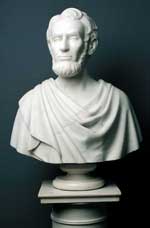VAM galleries including this work:
The Speed Art Museum | What’s the Point? | Young at Art || VAM Home
Albert P. Henry (American, 1836-1872)
BUST OF ABRAHAM LINCOLN, 1865
Marble; 24" in height
Deposited by the Citizens of Louisville
Courtesy of U.S. Judge Shackleford Miller and Mr. Neville S. Bullitt, PL43.1
The Speed Art Museum
This sculpture is a bust, or head-and-shoulders sculpture, of President Abraham Lincoln. It’s an example of neoclassical art—art that was inspired by the classical style of ancient Greece and Rome. The classical ideals of harmony, idealized realism, clarity, and reason are all apparent in the bust. During the 19th century, in both America and Europe, statues of national heroes made in the neoclassical style were quite popular.
Lincoln posed for the plaster model on which Albert P. Henry based this bust. It was one of the rare times that Lincoln actually posed for an artist.
In creating his bust of the president, Henry used both medium and processes to communicate meaning, striving to convey both Lincoln’s physical characteristics and personality. The sculptor simplified and smoothed over Lincoln’s somewhat homely features, a great example of idealized realism. Similarly, the president’s expression is thoughtful and grave, befitting a great leader who is both wise and sympathetic. Lincoln is shown here as a conscientious leader who sees clearly both the path the country needs to take and the terrible consequences of choosing such a path. The selection of white marble gives the bust a timeless quality, reminiscent of the sculpture of classical Greece and Rome. Perhaps most strikingly, Lincoln wears a toga-like garment instead of the usual men’s suit of the 1860s. By draping Lincoln in this neoclassical costume, Henry depicts Lincoln as a leader whose fame and greatness, like those of the ancient Greek and Roman heroes immortalized in ancient sculptures, will last for centuries.
Henry carved this marble bust in Italy. The Lincoln Monumental Association of Louisville purchased it in 1867. James P. Speed, who served as attorney general under Lincoln, spoke on the virtues of the late president at its unveiling ceremony in Louisville.
About the Artist
Like Lincoln, sculptor Albert P. Henry was born in Kentucky. Henry was born in Versailles, in Central Kentucky, but went to work as a clerk at an iron works in the small Western Kentucky town of Princeton as a young man. He fought for the North during the Civil War and was captured and sent to the Confederate Libby Prison in Richmond, Virginia. While imprisoned, he created sculptures by carving soup bones.
After the war, Henry moved to Washington, D.C. to study art. Lincoln was impressed by Henry’s war service and agreed to pose for him. Later, the president appointed Henry to the post of consul to Ancona, Italy so that the sculptor could continue his art studies there.
Classroom Ideas
Discussion: Do a visual inventory of the artwork. What does the bust tell you about Lincoln? Do your observations agree with the analysis above? Why or why not? View other depictions of Lincoln and compare them to this work in terms of how they convey Lincoln’s physical qualities and personality. Why would the neoclassical style be attractive to artists in portraying heroes? (Timeless quality; eternal; peaceful.)
View the commemorative Benin Head from Africa at the Speed Art Museum web site [www.speedmuseum.org/head.html]. The Lincoln bust and the Benin Head use completely different styles and cultural attributes, but both commemorate heroes. Make a list of similarities and differences between the two works.
Activities: Choose someone you consider a hero. List that person’s physical and personality traits, then create a drawing or sculpture of your hero in a neoclassical style. Write an artist’s statement detailing the choices you made in creating your artwork.
Links
Abraham Lincoln Online includes an extensive state-by-state Lincoln Sculpture Photo tour as well as numerous links to images of Lincoln, including photos, sculpture, and life masks.
[showcase.netins.net/web/creative/lincoln/art/sculpt.htm]
[showcase.netins.net/web/creative/lincoln/resource/sculpt.htm]

